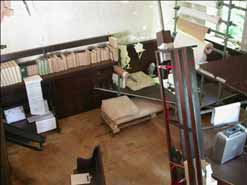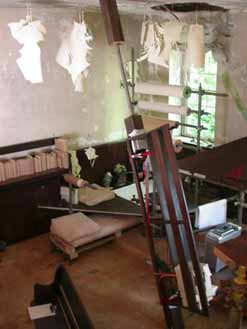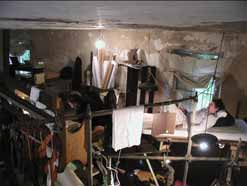



The Lost Meeting
The Lost Meeting, curated by Julie Courtney, took place in an old Quaker meetinghouse built in 1836 that lies within the Sculpture Park of Abington Art Center in Jenkintown, PA.
The “Little Abington Meetinghouse” was a long abandoned Quaker Meetinghouse that had been buried under weeds and trees for decades. The Lost Meeting transformed it into a temporary research studio/workshop for rethinking the role of “pattern making” in relation to the “everyday” and its mediators. While we notice our everyday life we often do not realize that mediation is central and it occurs everywhere and between us – it is what allows us to be part of a world. Inspired by vernacular Quaker life this research studio will make use of historical domestic Quaker objects/mediators such as clothing, furniture, children’s toys etc. The studio transformed these objects into new types of patterns and things that allowed us to begin to reconsider and transform what is our relation to the “everyday”. The studio itself becomes a form of “ambassador of difference”” that travels in between and across a terrain that involves the Quakers, other histories and events. Complementing this multi-layered installation was a musical composition from avant-garde and American Music Award-winning classical composer David Lang who wrote a piece based on a poem by William Penn.
J. Morgan Puett is a multidisciplinary artist/designer currently living and working in Northeastern Pennsylvania on the Mildred’s Lane Project (Co-founder/Director). and New York City. Puett’s work routinely meets at the intersection of history, fashion, architecture and fine art. Her Cottage Industry project for Spoleto, USA was a complex manifestation of a critique of the representation of the of history of the American textile and its industry in the form of an active and eventful practice of creating trans-historical clothing in a mid- 19th century home in Charleston , S.C.. This and other projects, such as Grafter’s Shack at WAVE HILL, in the Bronx, NYC, are elaborate, site-sensitive collaborations which dwell in the notion of invention through the re-construction of histories. In the collaboration RN:The Past, Present and Future of the Nurse’s Uniform (with Mark Dion and the Fabric Workshop and Museum), Puett and others create another trans-historical look into the tropes of knowledge of the future of nursing uniforms. Also, Puett, in collaboration with Suzanne Bocanegra, developed the The Manhattan Tartan Project that involved the development of Tartans for the city of Manhattan based on the demographics which detail the distribution of wealth and population of nationalities of New York City. Puett is represented by Alexander Gray Associates in NYC.
spurse is an international collective composed of individuals with experience in a wide variety of fields– visual art, statistics, urbanism, dance, architecture, computer programming, biology, geography, philosophy, psychology, bmx, etc; and works as a network with sub-groups and individuals located across the US, Canada, Mexico, Germany, Great Britain, Italy, Finland, Kenya and India. spurse has no (fixed) content or members.
David Lang is an American composer living in New York City. He was awarded the 2008 Pulitzer Prize for Music for The Little Match Girl Passion. Lang holds degrees from Stanford University, the University of Iowa, and Yale University (DMA, 1989).
His first recognition came from the BMI Foundation's Student Composer Awards in 1980 and 1981. Together with Julia Wolfe and Michael Gordon, Lang co-founded Bang on a Can in 1987. In 2002 he was awarded a grant from the Foundation for Contemporary Arts Grants to Artists Award.
In 2008 he joined the Yale School of Music composition faculty. He is also currently the Distinguished Visiting Professor of Composition and Composer in Residence at the Oberlin Conservatory.
Lang's music is informed by modernism, minimalism, and rock – and can perhaps be best described as post-minimalist or totalist. His music can be in turn comic, abrasive, and soothing, and it usually retains elements of conceptualism. He sometimes gives his concert pieces strange and even iconoclastic titles such as Eating Living Monkeys (1985) and Bonehead (1990).
